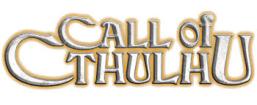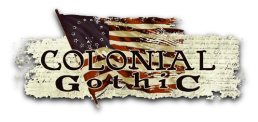Cthulhu 1776: Converting Colonial Gothic to Call of Cthulhu


A few months ago I posted about the release of the Colonial Gothic: Lovecraft sourcebook. The shadow of the Colonial period looms over much of Lovecraft’s writing, reflected in his descriptions of Innsmouth and Arkham and taking a more active role in stories like The Case of Charles Dexter Ward and The Dreams in the Witch-House. At an early stage in its development, Colonial Gothic itself was pitched to Chaosium as Cthulhu 1776. With the release of Colonial Gothic: Lovecraft, players can experience black-powder fantasy adventures against the horrors of the Cthulhu Mythos.
With the return of Greg Stafford and Sandy Petersen to Chaosium, the original Lovecraftian tabletop RPG looks set for a new lease on life. Based on Chaosium’s excellent Basic Roleplaying ruleset, Call of Cthulhu has been the leading Mythos-based RPG since it first appeared in 1981. Colonial Gothic is new by comparison, but the game’s core books can offer Call of Cthulhu players and Keepers the chance to explore the dark past of Lovecraft country.
One of my major concerns while developing Colonial Gothic: Lovecraft was ensuring that the game stats for the Mythos creatures were accurate and playable. I’m not ashamed to admit that I used the Call of Cthulhu rulebook as a reference, and while it was not the only factor in developing the creature stats, it proved a very useful numerical benchmark. I came up with the following rough system for converting between Call of Cthulhu and Colonial Gothic, and I am sharing it here because I think it could be useful to players of both games.
Colonial Gothic to Call of Cthulhu
Using this system, the Call of Cthulhu Keeper can turn many of Colonial Gothic’s adventures and sourcebooks into resources for an 18th-century Call of Cthulhu campaign, or just for a time-traveling side-track from one of Chaosium’s established timelines. The following titles are of particular interest to Call of Cthulhu fans:
- Second Edition Rulebook: contains general historical and setting information, equipment, prices, common character types, etc;
- Gazetteer: describes each of the Thirteen Colonies up to 1776, with notes on local mysteries and other items of interest;
- Boston Besieged: includes a detailed sourcebook on Boston during the siege of 1775-1776;
- The Philadelphia Affair: describes the city at the time of the Second Continental Congress and the drafting of the Declaration of Independence;
- Player Companion: includes detailed templates which are easily adapted to create period Investigator types for Call of Cthulhu;
- The Bestiary: presents a range of non-Mythos adversaries for rounding out Colonial-era adventures;
- Many other sourcebooks and adventures are available in print, PDF, ePub, and Kindle formats.
STR = Might * 1.67
CON = Vigor * 2.27
SIZ: generate from scratch, referring to similar characters/creatures in the Call of Cthulhu rules.
INT = Reason * 1.75
POW: generate from scratch, referring to similar characters/creatures in the Call of Cthulhu rules.
DEX = Nimble * 2.17
Skills and spells are hard to convert directly because of differences in the two game systems. However, with a little imagination an experienced Keeper should have no difficulty in coming up with numbers that work, based on the attribute scores, the overall concept and the relevant Colonial Gothic skill, spell, and Trait descriptions.
Call of Cthulhu to Colonial Gothic
A Colonial Gothic GM can use this system to help convert additional Mythos horrors from Call of Cthulhu sources: the copyright status of the Cthulhu Mythos is complex, and limited the range of creatures that could be covered in the Colonial Gothic sourcebook.
Might = STR * 0.6
Nimble = DEX * 0.46
Vigor = CON * 0.44
Reason = INT * 0.57
Resolution: generate from scratch, based on Reason score and POW * 0.5.
Vitality = (Might + Vigor) * 2.5, rounding down.
Skills, spells, and Traits can be adapted from Call of Cthulhu descriptions. Several new Traits, specific to the Cthulhu Mythos, are listed in the Colonial Gothic: Lovecraft sourcebook. The GM will find additional Traits in the Colonial Gothic Bestiary.
Converting Dice Rolls
The AnyDice converter provides a useful tool for examining probabilities: it converts the results of any dice roll into percentages. To see the probabilities for a 2d12 roll, enter output 2d12 in the top window and click the Calculate button immediately beneath.
Leave a comment Cancel reply
This site uses Akismet to reduce spam. Learn how your comment data is processed.
I don’t know if this is of any interest-
https://www.loc.gov/collections/historic-american-buildings-landscapes-and-engineering-records/?fa=location:connecticut&sp=3
– Library of Congress records of early American buildings; elevations, floor plans and photos (some of which are very evocative).
The linked page is for Connecticut, but there may be better regions for Colonial-era architecture.
And lots of the buildings are later, so could be used for CoC generally.
Thanks so much!